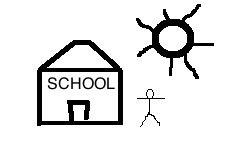I thought I’d share some notes and thoughts from recent tours of three new schools opening in my area.
* Science labs are cool! In all three of our new schools, there are nice, state-of-the-art science areas with fume hoods, eye wash stations, emergency showers and all sorts of experimentation areas. When I was in middle school, I’m not sure the gas was even turned on in the ‘lab’ area that was available. I don’t recall spending a ton of time in the lab area we had for my HS chemistry class, but that was several years ago and the room definitely felt cramped with the lab gear and the teaching space. That should be less of an issue in these new classrooms.
* One middle school had labs with the lecture-hall style of seating… tiered rows with dual front-facing desk space and rear-facing computer space. This is a really nice design, but care needs to be taken that maximum class sizes are considered in this design. When rooms like this are specifically built to accommodate 24 students and you have class sizes larger than that, problems could definitely arise.
* Every school had plans for quite a bit of wireless. At the secondary school level, an N-level wireless AP for every classroom is a minimum. Even if you are not currently in the midst of a 1:1 or BYOD initiative, proper planning today requires this level of wireless for a new school. Look at the advertised sales for your closest computer outlet. You’ll find wireless devices much easier than you’ll find the “old school” traditional wired desktop.
* At the risk of sounding really odd, there’s a part of me that’s still struck by the number of books and bookshelves in these new libraries. Maybe it’s the difference between pleasure reading and reference books (and I know there’s more to the story), but I feel like the growing popularity of e-readers and the use of the Internet as a primary research tool for most people would lead to a more noticeable change in the layout and focus of new school libraries.
* Various methods of providing interactive whiteboard functionality – one school had the “interactive projector” which (I assume) uses an interactive pen that interfaces with the projector to turn the traditional whiteboard into an interactive writing space. One school was planning to use traditional projectors in combination with the MimioTeach product to provide interaction. One school had PolyVision short-throw projector with the Eno whiteboard and pen combination for interaction. It simply shows that there’s no ‘right’ answer. What does your school district feel like best suits the teaching and learning efforts in your classrooms?
* McCracken County High School is certainly going to have options for their students! In addition to the more traditional teaching subject areas, we saw an ag science area, culinary arts department, pre-engineering, biomedicine, TV production and wonderful areas for band, chorus and voice, dance and a performing arts center. Small schools and districts have their advantages, but the breadth of programs that can be offered in a larger school is something to behold. Paducah Middle had a really nice band and vocal/chorus as well. I also noticed that the art area had a kiln. A kiln! Ceramics and pottery in a middle school?! Awesome! Lyon County Middle School had a different design, which is to be expected in a building to serve slightly under 300 students (versus these other building built for much larger populations). One neat feature I saw there was a retractable stage in their gymnasium, allowing stage space to be recaptured when it isn’t in use.
There is so much to see and to be considered when providing technology leadership during a new school construction or renovation. In all schools, we talked about wireless network density, computer placement in labs and classrooms, accommodations for presenters (e.g. teachers in many cases), intercoms and classroom audio, fire alarms, HVAC electronic controls, various security measures involving cameras and building access, wiring closet locations and requirements, and probably several other things that aren’t coming to mind right now. As a technology leader, I recommend that you find a way to join your facilities planning committee, long-term planning committee or similar group in your school district. Throughout these buildings, we stumbled across conversations that you wouldn’t think would involve technology… until they do.
It’s an exciting time for a school district and proper planning will hopefully help you avoid the little ‘nagging’ technology-related design issues that you’ll deal with in a new building – a building that will most likely be around longer than you’ll be in your current position!
